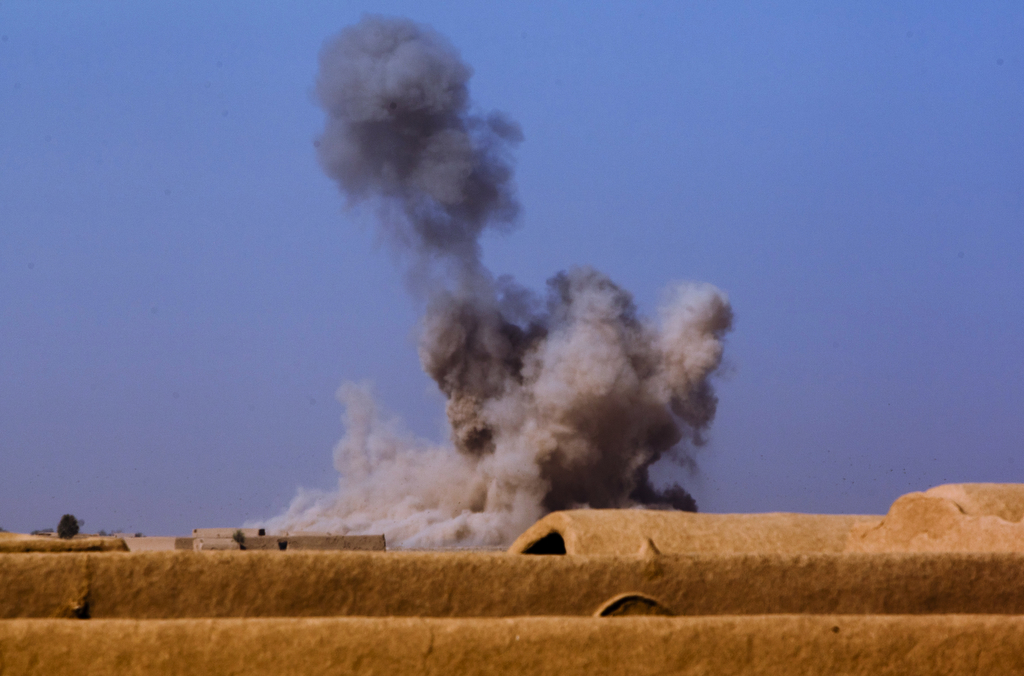Afghanistan: Immer mehr Schleier der Geheimhaltung
Die USA gehen zunehmend dazu über, seit Jahren veröffentlichte Informationen über militärische Aktivitäten in Afghanistan geheimzuhalten – und werden dabei von der NATO-geführten Resolute Support Mission unterstützt. Nach Angaben des US-Militärs soll das die Umsetzung des zwischen den USA und den Taliban geschlossenen Abkommens für eine Friedenslösung am Hindukusch erleichtern.
Über die aktuellste Einschränkung berichtete die US-Soldatenzeitung Stars&Stripes am (heutigen) Dienstag. Die Angaben zu Luftangriffen der US-Streitkräfte, seit mehr als zehn Jahren regelmäßig veröffentlicht, wird es künftig nicht mehr öffentlich zugänglich geben:
The U.S. military has stopped releasing information about airstrikes it conducts in Afghanistan, reversing a longtime policy amid a spike in violence in recent weeks, officials said.
The policy reversal was announced as the U.S. continues to withdraw troops as outlined in a peace deal with the Taliban, and days after a report said the military was withholding information on Taliban attacks. (…)
A separate monthly tally published by NATO’s Resolute Support mission detailing the number and location of U.S. airstrikes in Afghanistan has also been suspended, the RS mission said.
The number of sorties and munitions used in the campaign against the Islamic State group in Iraq and Syria will also be withheld from the public, said Capt. Kenneth A. Hicks, a spokesman for U.S. Air Forces Central Command. Those data had been published by AFCENT alongside the information on Afghanistan in recent years.
In der vergangenen Woche hatte der Special Inspector General for Afghanistan Reconstruction (SIGAR), der US-Beauftragte für die Kontrolle der Ausgaben in Afghanistan, eine erneute Einschränkung der Informationen durch die NATO-Mission und auch das US-Militär beklagt:
This quarter Resolute Support (RS) restricted from public release its data on enemy-initiated attacks (EIA) and effective enemy-initiated attacks (EEIA) for the first time since it began providing it to SIGAR in September 2018. Instead, in a statement issued to SIGAR, RS reported that from March 1–31, “the Taliban refrained from attacks against Coalition Forces; however they increased attacks against ANDSF to levels above seasonal norms.”
RS explained its decision to restrict the data by saying “EIA are now a critical part of deliberative interagency discussions regarding ongoing political negotiations between the U.S. and the Taliban.” DOD added that after the deliberative process ends, the data could again become releasable to the public.
EIA data was one of the last remaining metrics SIGAR was able to use to report publicly on the security situation in Afghanistan since RS discontinued its previous system of assessing district control in 2018. Also this quarter, USFOR-A classified all ANDSF casualty information because the Afghan government classifies it.
Vor dem Hintergrund des erklärten Willens von US-Präsident Donald Trump, die Truppen so schnell wie möglich vom Hindukusch nach Hause zu holen, und der Vereinbarung zwischen den USA und den Taliban scheint es darum zu gehen, öffentliche Überprüfung des aktuellen Vorgehens der US-Truppen auszuschalten. Eine nachprüfbare Darstellung der Sicherheitslage, darauf weist SIGAR hin, gibt es nunmehr nicht mehr; außerdem auch keine Übersicht über Luftangriffe.
Dass eine NATO-geführte Mission (die in der Befehlskette auch einem deutschen General untersteht, nämlich dem Befehlshaber des Joint Forces Command Brunssum) diese Einschränkungen voll mitträgt, ist zumindest … interessant.
(Archivbild: A mushroom cloud rises into the air following an airstrike on confirmed enemy positions during a patrol near Forward Operating Base Shir Ghazi, Helmand province, Afghanistan, Aug. 28, 2013 – Cpl. Paul Peterson/Marine Expeditionary Forces)




„Dass eine NATO-geführte Mission (die in der Befehlskette auch einem deutschen General untersteht, nämlich dem Befehlshaber des Joint Forces Command Brunssum) diese Einschränkungen voll mitträgt, ist zumindest … interessant.“
Dass führt uns plastisch die Machtverhältnisse in der Allianz vor Augen und wirft mal wieder ein erhellendes Licht auf die so oft angeführte Aussage von den 29 gleichberechtigten Mitgliedern der NATO. Das ist ein wichtiger Teil der Realität und der externen Wahrnehmung der NATO durch Dritte, über die wir uns dann immer wundern.
@iroquois
+1 mit Sternchen
Wenn diese Entscheidung dauerhaft Bestand hat, dann ist es mal wieder ein Stück Holz in der Argumentation derjenigen, die das Feuer anheizen wollen gegen eine US-geführte NATO.
Die Maßnahme ist meiner Meinung nach auch alles andere als freiheitlich demokratisch, so wie wir unser System anderen Systemen immer verkaufen wollen.
Ich sehe das etwas differenzierter.
Ja, mehr Transparenz ist generell wünschenswert, aber militärische Operationen und diplomatische Verhandlungen bedingen beide häufig (leider) einen gewissen Anteil ein Verschwiegenheit.
Und mit Blick auf die Dominanz der USA.
Das ist ganz einfach: Wenn wir (EUR und besonderes DEU) mehr einbringen, dann können wir auch mehr mitbestimmen. In der NATO steigt der tatsächliche Einfluss maßgeblich mit dem tatsächlichen Beitrag.
Aus meiner Sicht, will Donald Trump vor allem raus, und das vor den US Wahlen. Und persönlich gebe ich Ihm recht!
Von vornerein war dieser Krieg nicht gewinnbar,. Mehr einbringen in Afganistan ist eine reine Ressourcenverschwendung,
„gewissen Anteil ein Verschwiegenheit.“
Die Verluste der Afghanen nicht mitteilen ist ja in Ordnung.
Hier wird aber nicht etwas verschwiegen, sondern alles!
Das ist ein großer Unterschied und hat nichts mit Diplomatie und militärischer Geheimhaltung zu tun.
Es wäre völlig in Ordnung wenn man selbst eine Woche später nach einem Angriff diesen Angriff mitteilt und die Anzahl an abgeworfenen Bomben. Da hat man keine Operation gefährdet, in einer Woche weiß der Feind das auch schon.
Aber nichts öffentlich mitteilen geht in meinen Augen in einer Demokratie nicht.
“ the data could again become releasable“
Allein schon das „could“ ist so falsch.
Dieses Vorgehen wirft natürlich die Frage auf, was man so plötzlich zu verheimlichen hat?